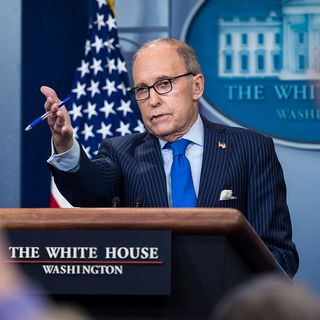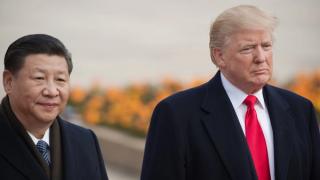Donald Trump insists that trade wars are “good and easy to win” and that the United States has nothing to lose from taking a confrontational approach to China on trade. He cites the size of the US trade deficit with China as evidence that there’s much ground to gain back. “When you’re already $500 Billion DOWN, you can’t lose!” Trump tweeted in early April.
On 6 July, the US and China each imposed tariffs on US34 billion-worth of each other's goods. China's in-kind response to the original US tariffs prompted the Trump administration to formally announce a further US200 billion-worth of Chinese good to impose tariffs of 10 per cent on. When this was initially threatened in June, China again promised to respond and, if this happens, Donald Trump has assured voters he will keep upping the ante with tariffs on a further US200 billion worth of goods.
So what is a trade war? Does the United States really stand to lose nothing? What measures is the Trump administration taking against China? And what are the implications for global trade?
What is a trade war?
A trade war is a situation in which two or more countries impose heavy quotas or tariffs – essentially taxes on foreign imports – on each other in an escalating manner. Whether it’s quotas that decrease the level of imported products, or tariffs that increase the cost of importing them, the intent is to reduce relative foreign competition.
While the measures imposed by the combatants can target specific sectors, the increasingly transnational nature of trade and the modern supply chain makes it very difficult to limit a trade war to two countries. Self-inflicted wounds and collateral damage to other countries are inevitable. This is especially so when the two main countries involved are China and the United States – the world’s two largest economies. Tariffs on particular products inevitably affect a wide range of countries, potentially bringing them into the conflict.
US tariffs on US34 billion of Chinese goods are in effect and there are a further US16 billion worth of goods with tariffs pending. Steel and aluminium tariffs are in effect for some countries, but are still the subject of negotiations with some trading partners, including Australia.
Does the US stand to lose anything in a trade war?
Yes.
Using the trade deficit with one country as a measure of economic success is an economically myopic approach, but one that that fits the neat Trump rhetoric of winners and losers. In practice, it is not a zero-sum game. Trade deficits reflect the difference between domestic saving and investment. For every dollar added to the trade deficit, there is a corresponding capital inflow into the US underpinning investment, economic growth and employment. Narrowing the trade deficit would imply less foreign investment in the US, something Trump says he also wants. The US337 billion trade deficit between the United States and China is an arbitrary construct that says little about value added in the two economies.
Imposing tariffs on steel gives a competitive advantage to US steel manufacturers but raises the cost of business for the multitude of other US manufacturers, like the automobile industry, which use steel in production. These manufacturers then pass the cost on to US consumers.
In recent decades, the United States has made a strong swing toward being a predominantly service-based economy. Between automation and the cheap cost of labour overseas, the number of Americans working in manufacturing has plummeted, although manufacturing output has increased due to increased productivity. Cheap Chinese imports lower costs for many businesses and they also reduce the cost of living for Americans. When tariffs are introduced, the gross benefit to one industry can be heavily outweighed by the net damage done. For example, imposing tariffs on steel gives a competitive advantage to US steel manufacturers but raises the cost of business for the multitude of other US manufacturers, like the automobile industry, which use steel in production. These manufacturers then pass the cost on to US consumers.
The other metric of success used by Trump, the stock market, clearly demonstrates the damage a trade war would deal to the United States. The proposed tariffs have intermittently injected uncertainty into associated sectors of the market, which have dragged down the market as a whole.
The United States is not alone in condemning some of China’s trade practices as violations of their obligations under international trade law – particularly with reference to intellectual property rights. But by forgoing the opportunity to act as a coalition and instead unilaterally imposing tariffs to combat this outside of the World Trade Organisation, the Trump administration is opening itself up to retaliation from nations that actually agree with it, reducing its leverage.
The implications are more than just economic. The country hardest hit by the washing machine and solar tariffs was South Korea, a staunch US ally. Likewise, when Robert Lighthizer announced the plan to impose a 25 per cent tariff on steel imports and a 10 per cent tariff on aluminium, the country hardest hit was Canada, near-kin to the United States. There is a loss of good-faith involved in these interactions that could jeopardise confidence in the United States as a stable trading partner.
There is a loss of good-faith involved in these interactions that could jeopardise confidence in the United States as a stable trading partner.
Trump, too, stands to lose from a trade war. China's response to US tariffs on US50 billion-worth of goods includes tariffs on pork, soybeans and other key agricultural exports. The mere threat of these is already having an enormous impact on states like Iowa where soybean exports are significant. Part and parcel of Trump’s promise to ‘make America great again’ was to boost the agricultural sector. As the destination for the majority of US agricultural exports, China has the potential to drive a wedge between Trump and his base over trade.
In short, the Trump administration's potential 'losses' from pursuing a trade war with China are not only economic, but diplomatic and political to boot.
What measures is the Trump administration taking against China?
The Trump administration has been using sections of US trade law that are rarely used, although not unprecedented. Each round of US tariffs has been justified on the basis of a different section of US trade law and has different implications for global trade.
Round 1: Section 201
The US tariffs on washing machines and solar energy elements are part of what are called safeguard measures. This essentially means tariffs are imposed on foreign imports of a product deemed to be increasing at a rate that hurts domestic industry. Safeguard measures are designed to be temporary.
The United States International Trade Commission (USIT) – an independent federal agency that administers US trade laws - will only consider a Section 201 case following a petition from affected parties. In this case, whitegoods manufacturer Whirlpool and solar companies Suniva Inc. and SolarWind Americas made the case that they were unable to compete in a flooded market due to Chinese and Korean imports.
The last time the United States used section 201 was under the Bush administration, which used it to impose tariffs of up to 30 per cent on steel imports in 2002. The move was widely criticised in the United States and abroad, and eventually deemed illegal by the WTO, forcing the president to withdraw the tariffs after 21 months. Safeguard measures are widely used and are perfectly legal under domestic and international trade law, although economically rarely justified.
Round 2: Section 232
When the Trump administration announced a 25 per cent tariff on imports of steel and a 10 per cent tariff on imports of aluminium, many believed this was the beginning of a China-US trade war in earnest.
In this case, the administration used Section 232 of the Trade Expansion Act of 1962, which gives the president the authority to impose remedies if foreign trade is determined to pose a threat to national security.
The concept is that the United States should not be so dependent on a foreign product that if imports were suddenly halted it would be unable to meet basic demand. Or, as President Trump explained: “If we ever have a conflict, we don't want to be buying the steel from a country that we're fighting because somehow that doesn't work very well.”
Proximity vs principles: Who is Larry Kudlow, Trump's chief economic advisor?

But the national security argument in this case is not well founded. The largest share of US steel imports comes from allies, making a situation in which US supply and security are severely threatened by a steel shortage highly unlikely. The White House has already contradicted its ethos by granting exemptions to some US allies, including Australia, while pushing ahead with Canada and the European Union.
This weak foundation is the root of unprecedented US tension with Canada, which peaked during June's G7 summit in La Malbaie, Quebec. Canadian Prime Minister Justin Trudeau labelled the measures "kind of insulting" and has promised to issue counter-tariffs. In turn, White House trade advisor Peter Navarro said of Trudeau's criticism that there is "a special place in hell for any foreign leader that engages in bad-faith diplomacy with President Donald J. Trump," before accusing him of stabbing the president in the back. The jarring reaction of Canada and Europe to the tariffs stems from both the justification and the potential impact on the world trading order.
The WTO's General Agreement on Tariffs and Trade (GATT) Article 21 provides a self-judging national security exception under its rules, but one that is rarely invoked because of the potential for abuse. The disingenuous claim by the United States in this case is an act of bad faith that could set a dangerous precedent and threaten the discipline that holds the world trading system together.
If the target is China, the US is shooting through its own foot and into the ground to hit it.
This is the first time since the WTO was established in 1995 that the United States has used Section 232. It was last used by President Reagan in 1986 in relation to imports of machine tools.
The United States previously used Section 232 to tax foreign oil in 1971 and 1975 under presidents Nixon and Ford respectively due to the oil crises.
Round 3: Section 301
In early April, the president proposed US50 billion worth of tariffs on Chinese goods and electronics imports under Section 301 of the Trade Act. The broad sweep of these tariffs seemed to be the surest sign yet that a trade war was underway.
Following reciprocal trade talks in Beijing and Washington the tariffs were temporarily "suspended" but, the Trump team forged ahead and imposed the tariffs on 6 July 2018. The value of items addressed by the tariffs was been reduced to US34 billion, with the remaining US16 billion still pending after negotiations with affected parties in the US.
China is yet to flinch in its responses to US trade actions, threats and demands. So with Trump considering tariffs on Chinese goods in increments of US200 billion every time Beijing matches US actions, there is no clear end in sight.
Beijing's in-kind response to these tariffs crucially includes duties on soybeans, wheat, corn, beef, poultry and pork. The size of the US agricultural export market in China shows that Beijing is both willing to hit Trump where it hurts, and suffer shortages itself. China is yet to flinch in its responses to US trade actions, threats and demands. So with Trump apparently considering tariffs on Chinese goods in increments of US200 billion every time Beijing matches US actions, the only clear end in sight is tariffs on all two-way trade between the countries. But even then, there is a suite of other measures both countries could use to inflict further pain.
The Trump administration has already floated employing the rarely-used International Emergency Economic Powers Act of 1977 to significantly limit Chinese investments in the US, but instead opted to work with Congress on new legislation.
By targeting Chinese electronics (excluding phones and televisions) Donald Trump brought to fruition years of rhetoric railing against a Chinese law requiring foreign companies to form joint-ventures with local state-owned firms – resulting in the theft of intellectual property. There are estimates that the US financial loss from IP theft is up to US600 billion annually.
Beijing has expanded on the law and is now demanding companies like Apple hand over proprietary source code. Indeed, in February this year Apple moved all of its Chinese user’s iCloud data to Chinese state-owned servers, giving the government access. It is discriminatory, dangerous, and condemned by multiple members of the WTO, as well being a breach of China’s WTO Accession Protocol.
But President Trump has opted to act alone. Section 301 allows the president to impose unilateral tariffs on countries that “burden, restrict, or discriminate against United States commerce,” but only where the WTO does not have jurisdiction, which is not the case here. Although 301 investigations have taken place since the WTO was founded in 1995, no tariffs have been imposed on the back of them.
The use of Section 301 to escalate tariffs on Chinese goods shows Donald Trump’s contempt for the WTO – where this IP dispute would traditionally play out.
How Trump should really tackle Beijing's technology thefts

In 2017, Trump told Fox News: “The WTO was set up to benefit of everybody but us… We lose the lawsuits, almost all of the lawsuits in the WTO." This is demonstrably false.
By circumventing the WTO and acting unilaterally under Section 301, the president is foregoing the opportunity to bring maximum pressure on China to change by acting in coalition with other countries. Indeed, the US has previously brought successful WTO actions against Chinese intellectual property rights violations.
Means to what end?
For what it’s worth, those near Trump like White House economic advisor Larry Kudlow and Commerce Secretary Wilbur Ross have called for calm, insisting that “we are not entering World War III” and that “even shooting wars end with negotiations”. Some pundits hypothesised that noise coming from the Trump White House was a posturing ploy to obtain concessions. This is the tactic the president pursued in the renegotiation of the Korea US Free Trade Agreement (KORUS). If this was the case, the bluff has gone too far. Real tariffs and real responses to them have already resulted and concessions are scant.
When the target is China, unconventional interpretations of trade law and a misguided reliance on trade deficits as markers of economic success will continue to wreak havoc on US exporters, the stock market and alliances. The cycle of tariffs and counter tariffs ad-infinitum - or until Trump or Xi Jinping relent - will increasingly worsen conditions for American voters. The pain will be sharpest in the agricultural (and Trump) heartland where China is directing the bulk of its response.






